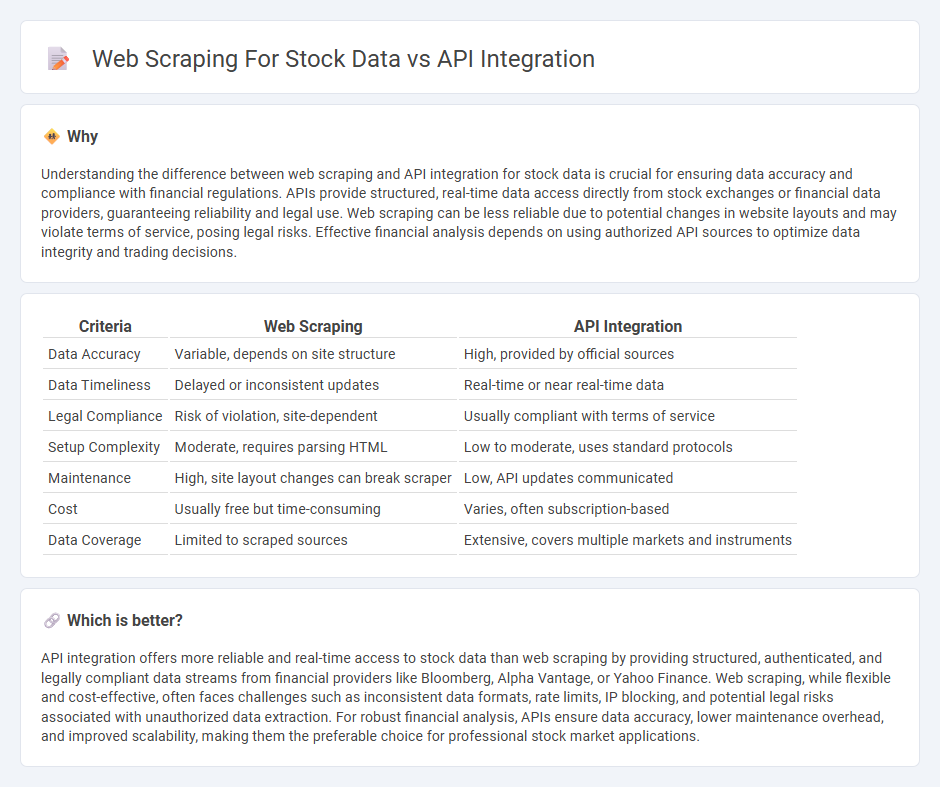
Web scraping for stock data involves extracting information directly from financial websites, enabling access to diverse and up-to-date market data without relying on official sources. API integration provides a structured and reliable method to retrieve stock prices and financial metrics through authorized endpoints, often with enhanced speed and data accuracy. Explore the advantages and limitations of both methods to optimize your stock data acquisition strategy.
Why it is important
Understanding the difference between web scraping and API integration for stock data is crucial for ensuring data accuracy and compliance with financial regulations. APIs provide structured, real-time data access directly from stock exchanges or financial data providers, guaranteeing reliability and legal use. Web scraping can be less reliable due to potential changes in website layouts and may violate terms of service, posing legal risks. Effective financial analysis depends on using authorized API sources to optimize data integrity and trading decisions.
Comparison Table
| Criteria | Web Scraping | API Integration |
|---|---|---|
| Data Accuracy | Variable, depends on site structure | High, provided by official sources |
| Data Timeliness | Delayed or inconsistent updates | Real-time or near real-time data |
| Legal Compliance | Risk of violation, site-dependent | Usually compliant with terms of service |
| Setup Complexity | Moderate, requires parsing HTML | Low to moderate, uses standard protocols |
| Maintenance | High, site layout changes can break scraper | Low, API updates communicated |
| Cost | Usually free but time-consuming | Varies, often subscription-based |
| Data Coverage | Limited to scraped sources | Extensive, covers multiple markets and instruments |
Which is better?
API integration offers more reliable and real-time access to stock data than web scraping by providing structured, authenticated, and legally compliant data streams from financial providers like Bloomberg, Alpha Vantage, or Yahoo Finance. Web scraping, while flexible and cost-effective, often faces challenges such as inconsistent data formats, rate limits, IP blocking, and potential legal risks associated with unauthorized data extraction. For robust financial analysis, APIs ensure data accuracy, lower maintenance overhead, and improved scalability, making them the preferable choice for professional stock market applications.
Connection
Web scraping for stock data extracts real-time financial information from publicly available websites, enabling the collection of diverse market metrics such as prices, volumes, and company performance indicators. API integration streamlines this process by providing structured, reliable access to stock data directly from financial service providers, reducing the need for manual extraction and improving data accuracy. Combining web scraping with API integration enhances the breadth and depth of stock market analysis, supporting automated trading systems and informed investment decisions.
Key Terms
Data Accuracy
API integration delivers real-time, structured stock data with higher accuracy by accessing official market feeds directly from exchanges or data providers. Web scraping extracts data from web pages, which can be outdated or inconsistent due to page changes, leading to reduced reliability and potential errors. Explore the best method for your financial data needs to ensure precision and consistency.
Real-time Access
API integration provides direct, real-time access to stock data with high reliability and minimal latency, ensuring up-to-date pricing and market movements. Web scraping, while useful for gathering information from websites, often faces delays, data inconsistency, and potential legal issues, making it less suitable for time-sensitive stock data. Explore the advantages of API integration for accurate and efficient real-time stock data retrieval.
Compliance
API integration offers structured access to stock data with adherence to exchange regulations and data provider licenses, ensuring compliance and minimizing legal risks. Web scraping, while often used to bypass API restrictions, may violate terms of service and data usage policies, leading to potential legal actions and data accuracy concerns. Explore the differences in compliance requirements and best practices to determine the safest approach for stock data acquisition.
Source and External Links
10 Common API Integration Examples and Why You Need ... - API integration is the process of connecting different software applications through their APIs to exchange data and perform coordinated functions, with common examples including social media, payment gateway, CRM, and cloud storage integrations that automate workflows and enhance functionality.
API Integration: A Comprehensive Introduction - API integration enables different applications to communicate and share data seamlessly, such as syncing data between Salesforce and Marketo to keep prospect information updated in both systems automatically.
What is API Integration? - Cleo - API integration works by linking platforms using specific protocols, allowing managing and automating administrative, configuration, and monitoring tasks without traditional user interfaces through APIs, also known as "headless" operation.
 dowidth.com
dowidth.com